-
Out of stock
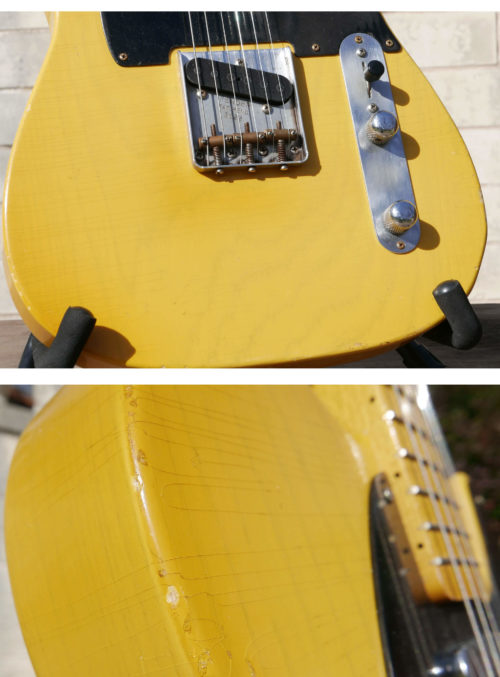 This could be the best blackguard telecaster tribute ever. An homage to the great early 50’s telecaster. But it only gets accolades if it’s a great player. This one is a great player–its light weight (same weight range as on original early 50s telecaster), pickups, setup, and attention to detail make for a great sounding tele. A joy to play. There appear to be a few original 1952/1953 parts on this guitar– but this guitar is being offered strictly as a reproduction/tribute. And it’s a tribute, in its way, to the art of the (great) copy– and on that note, it comes with Nacho Baños’ great book, The Blackguard book (out of print and a $300-400 value in itself), with matching serial number on the cover of the book. (Click here for a story on Baños.) So the purchaser can follow along the narrative of some of the great original early Blackguards in the book–and how to identify original early 50’s Telecaster, Nocaster, and Esquire elements and parts– while having fun with this intriguing tribute guitar. • The bridge, a good reproduction of unknown origin. The photos tell the story. (Original early 50’s brass saddles?). Reproduction tuners. • The pickguard looks convincing, but we're calling it a reproduction. • Seymour Duncan Antiquity pickups. • The pots, and the pickup switch, appear to be original 1952 or 1953 Fender parts (but not with original solder joints etc). • The control plate appears to be an original 1952/1953 Fender plate. Tone, volume knobs are (good) reproductions. • Neck is from Mark Jenny, stamped on heel as official Fender “Licensed” neck. Medium C profile. Great feel– not baseball bat, and not too thin. • Weight, with strings: 6.625 lbs. This is in the same weight range as original early 50s telecasters. Compare to the weight of mediocre telecaster “reissues” on the market today, all of which weigh much more. • The body is by Mark Jenny. We waited patiently for over a year until the right Jenny body became available, to complete this instrument in the best way possible and to remove from the market the (nice light weight) reproduction body that was in place when we acquired the guitar that had a non-authentic 1952 date and signature in the neck pocket. The right thing to do– and the Mark Jenny body in place now has crazing and other elements characteristic to the early blackguard look, weight, wear, and feel. • Set up perfectly, and ready to play. Sold as a reproduction/tribute guitar only, together with the Nacho Baños The Blackguard book (book in as-new condition in original box) that will school the new owner on how to evaluate the fine, fully pedigreed, great Blackguards of the early 50’s. Price: $5950.
This could be the best blackguard telecaster tribute ever. An homage to the great early 50’s telecaster. But it only gets accolades if it’s a great player. This one is a great player–its light weight (same weight range as on original early 50s telecaster), pickups, setup, and attention to detail make for a great sounding tele. A joy to play. There appear to be a few original 1952/1953 parts on this guitar– but this guitar is being offered strictly as a reproduction/tribute. And it’s a tribute, in its way, to the art of the (great) copy– and on that note, it comes with Nacho Baños’ great book, The Blackguard book (out of print and a $300-400 value in itself), with matching serial number on the cover of the book. (Click here for a story on Baños.) So the purchaser can follow along the narrative of some of the great original early Blackguards in the book–and how to identify original early 50’s Telecaster, Nocaster, and Esquire elements and parts– while having fun with this intriguing tribute guitar. • The bridge, a good reproduction of unknown origin. The photos tell the story. (Original early 50’s brass saddles?). Reproduction tuners. • The pickguard looks convincing, but we're calling it a reproduction. • Seymour Duncan Antiquity pickups. • The pots, and the pickup switch, appear to be original 1952 or 1953 Fender parts (but not with original solder joints etc). • The control plate appears to be an original 1952/1953 Fender plate. Tone, volume knobs are (good) reproductions. • Neck is from Mark Jenny, stamped on heel as official Fender “Licensed” neck. Medium C profile. Great feel– not baseball bat, and not too thin. • Weight, with strings: 6.625 lbs. This is in the same weight range as original early 50s telecasters. Compare to the weight of mediocre telecaster “reissues” on the market today, all of which weigh much more. • The body is by Mark Jenny. We waited patiently for over a year until the right Jenny body became available, to complete this instrument in the best way possible and to remove from the market the (nice light weight) reproduction body that was in place when we acquired the guitar that had a non-authentic 1952 date and signature in the neck pocket. The right thing to do– and the Mark Jenny body in place now has crazing and other elements characteristic to the early blackguard look, weight, wear, and feel. • Set up perfectly, and ready to play. Sold as a reproduction/tribute guitar only, together with the Nacho Baños The Blackguard book (book in as-new condition in original box) that will school the new owner on how to evaluate the fine, fully pedigreed, great Blackguards of the early 50’s. Price: $5950. -
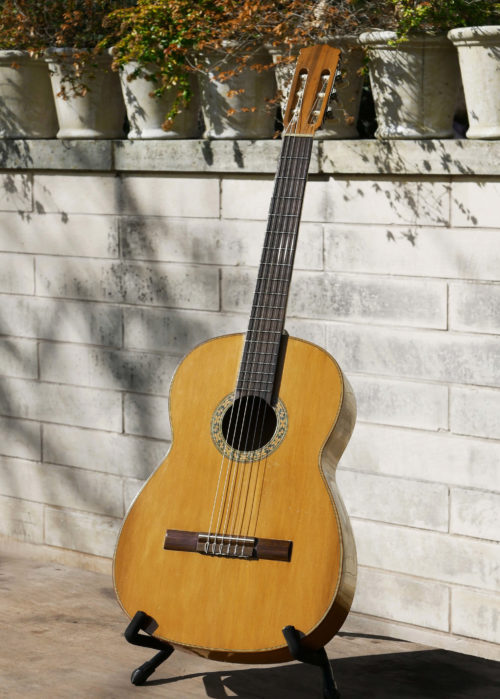 Another instrument from Enos Hernandez of Mexico, one of the best luthiers to ever live in work in Mexico, circa 1970’s. This one is a flamenco Blanca, with the classic cypress back and sides. Like the other Enos Hernandez we have, this one also has a cedar top. The instrument is super light weight, as a Flamenco Blanca should be, and it’s bright and percussive and raspy as a good Blanca should be. There is a scratch (not a crack) on back of guitar (see photo). There are dot position markers – original to the guitar, i.e. not added later – on top edge of fretboard (frets 3,5,7,9 – see photo). Scale length: 660mm Available January 2018 Price: $2950
Another instrument from Enos Hernandez of Mexico, one of the best luthiers to ever live in work in Mexico, circa 1970’s. This one is a flamenco Blanca, with the classic cypress back and sides. Like the other Enos Hernandez we have, this one also has a cedar top. The instrument is super light weight, as a Flamenco Blanca should be, and it’s bright and percussive and raspy as a good Blanca should be. There is a scratch (not a crack) on back of guitar (see photo). There are dot position markers – original to the guitar, i.e. not added later – on top edge of fretboard (frets 3,5,7,9 – see photo). Scale length: 660mm Available January 2018 Price: $2950 -
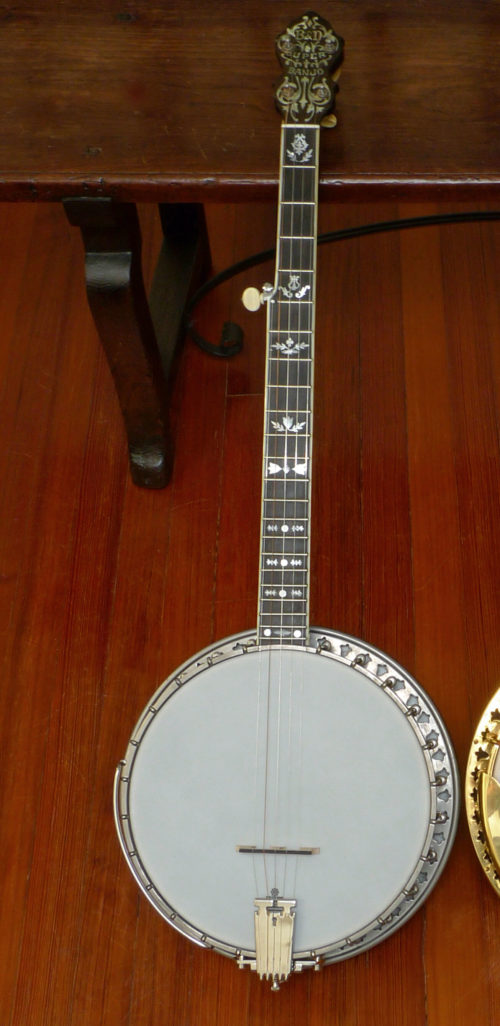 This is a superb sounding 5 string banjo. Original nickel plating. • Bacon & Day Super, 5-string Banjo (Style A) Serial number: 25892 (early 1928) • Resonator, stamped on inside (in nickel-laminated maple): Bacon Banjo Co., Inc. Groton, CT. U.S.A. Dec. 20th, 1927 • Conversion, 5 string neck (original neck was probably a tenor or plectrum); Presumably, this neck is newer than the banjo– yet the advanced MOP fret markers are as found on the earliest versions of B&D Super banjos. We assume this neck was built by one of the best U.S. “conversion” builders – with a re-use of the original MOP inlay at the peghead plus the dowel stick. Maple neck, with steel reinforcing rod. Fretboard is beautiful jet-black ebony; multi-layer neck bindings. Fretboard is a very comfortable 1 3/8 inches wide at the nut, 1 7/8 wide where fretboard meets body. • Nickel plated • 22 frets • Scale length: 27 inches • Extended Maple resonator– nickel laminated on inside • Original flat Tulip-hole flange (not the “add-on” round-hole resonator of earlier years). • Original, top of the line Type III Silver Bell tone ring (No Hole tone ring) original to the instrument (this is the most sought-after, advanced Silver Bell tone ring, introduced early 1927). • Original 2 band Grover geared tuning pegs • Fults tailpiece, and included a variety of Fults tone pins. Bob Fults made the best tailpieces available. And his tone pins let you tweak the tone of your banjo. There are several interchangeable Fults pins included here– ivory, ebony, lead, sterling silver, brass, and copper. Plus a “tone lock”. (Bob Fults recently retired, and these highly sought after Fults tailpieces and pins are no longer available.) In its original hard shell Lifton case. $3750.
This is a superb sounding 5 string banjo. Original nickel plating. • Bacon & Day Super, 5-string Banjo (Style A) Serial number: 25892 (early 1928) • Resonator, stamped on inside (in nickel-laminated maple): Bacon Banjo Co., Inc. Groton, CT. U.S.A. Dec. 20th, 1927 • Conversion, 5 string neck (original neck was probably a tenor or plectrum); Presumably, this neck is newer than the banjo– yet the advanced MOP fret markers are as found on the earliest versions of B&D Super banjos. We assume this neck was built by one of the best U.S. “conversion” builders – with a re-use of the original MOP inlay at the peghead plus the dowel stick. Maple neck, with steel reinforcing rod. Fretboard is beautiful jet-black ebony; multi-layer neck bindings. Fretboard is a very comfortable 1 3/8 inches wide at the nut, 1 7/8 wide where fretboard meets body. • Nickel plated • 22 frets • Scale length: 27 inches • Extended Maple resonator– nickel laminated on inside • Original flat Tulip-hole flange (not the “add-on” round-hole resonator of earlier years). • Original, top of the line Type III Silver Bell tone ring (No Hole tone ring) original to the instrument (this is the most sought-after, advanced Silver Bell tone ring, introduced early 1927). • Original 2 band Grover geared tuning pegs • Fults tailpiece, and included a variety of Fults tone pins. Bob Fults made the best tailpieces available. And his tone pins let you tweak the tone of your banjo. There are several interchangeable Fults pins included here– ivory, ebony, lead, sterling silver, brass, and copper. Plus a “tone lock”. (Bob Fults recently retired, and these highly sought after Fults tailpieces and pins are no longer available.) In its original hard shell Lifton case. $3750. -
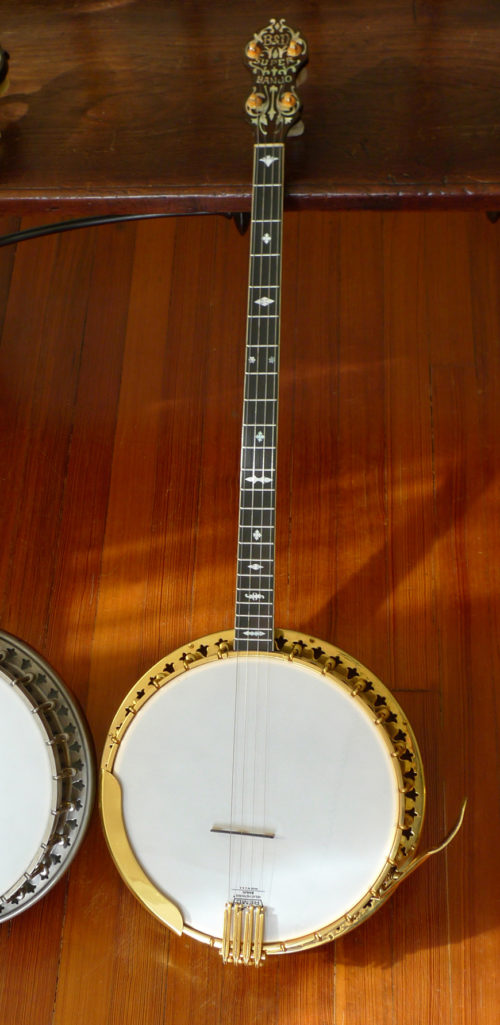 This rare 1926 example of Bacon & Day’s Super, Plectrum banjo is in wonderful condition– collectors quality, but it plays wonderfully. And this is the rare “Super” model A, gold plated. (All original, and with matching serial number on rim and dowel stick.) Original soft pedal stamped "Pat. Pend. B.&D. Soft Pedal." The original gold plating is in great condition, showing extremely little tarnishing, and no thin spots. In fact the banjo shows very little playwear at all. Original plectrum neck, original armrest– in fact all parts are original. Produced in the golden age of Bacon & Day (B&D) production, this banjo was made in Groton, CT. Although the earliest Bacon banjos were produced by various makers for Bacon from 1906-1920, the company’s best era began in 1922 when David Day left the Vega company to partner with Fred Bacon who had begun crafting his instruments in-house in 1920. The B&D banjos produced in this era are of considerably higher quality and are the sought after models by both players and collectors. The photos tell the story. 26 inch scale length. 22 fret plectrum 11″ rim In a recent hard shell case. ... no longer available ...
This rare 1926 example of Bacon & Day’s Super, Plectrum banjo is in wonderful condition– collectors quality, but it plays wonderfully. And this is the rare “Super” model A, gold plated. (All original, and with matching serial number on rim and dowel stick.) Original soft pedal stamped "Pat. Pend. B.&D. Soft Pedal." The original gold plating is in great condition, showing extremely little tarnishing, and no thin spots. In fact the banjo shows very little playwear at all. Original plectrum neck, original armrest– in fact all parts are original. Produced in the golden age of Bacon & Day (B&D) production, this banjo was made in Groton, CT. Although the earliest Bacon banjos were produced by various makers for Bacon from 1906-1920, the company’s best era began in 1922 when David Day left the Vega company to partner with Fred Bacon who had begun crafting his instruments in-house in 1920. The B&D banjos produced in this era are of considerably higher quality and are the sought after models by both players and collectors. The photos tell the story. 26 inch scale length. 22 fret plectrum 11″ rim In a recent hard shell case. ... no longer available ... -
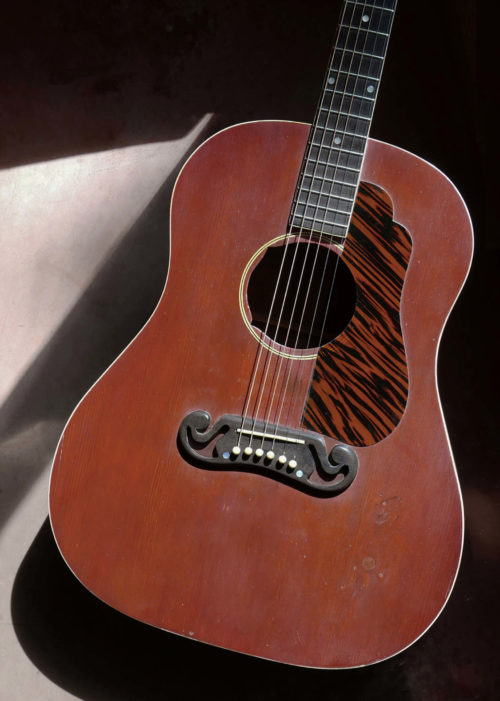 This is not your father’s J-55. And it’s not a $20K guitar. It is a wonderful player. This is an original 1939 Gibson Jumbo 55, also called the “J-55”, serial # EA5652. It is the rare, stair step headstock model, only made for a brief window in the late 30’s. It delivers the trademark, large body, prewar, long scale Gibson tone, like no other. It plays beautifully, with original bridge, frets, braces. This guitar has of course the original, Mustache bridge, and more rare– the stair step headstock. Original bridge plate. Original binding including on fretboard. Original pearl logo on the headstock (with original finish). The pickguard is a nitro cellulose reproduction meticulously crafted in our shop. It has the long scale, 25 ½ inches, that makes this model so great. And a little-known original feature of this rare model is that it has a 1 11/16 nut width, that combined with the low action makes it effortless to play, and with tone that cannot be equaled in any postwar Gibson. The intonation is spot-on, and the intonation and fretting/action are great even at the high fret positions. It was refinished in a deep Gibsonesque red, decades ago– and that makes this guitar the most affordable true 1939, stairstep headstock J-55 you will ever find. (Top thickness is fine, there was no thinning in the past). The tone is superb. And the action is superb– low and fast without sacrificing tone or volume at all.
This is not your father’s J-55. And it’s not a $20K guitar. It is a wonderful player. This is an original 1939 Gibson Jumbo 55, also called the “J-55”, serial # EA5652. It is the rare, stair step headstock model, only made for a brief window in the late 30’s. It delivers the trademark, large body, prewar, long scale Gibson tone, like no other. It plays beautifully, with original bridge, frets, braces. This guitar has of course the original, Mustache bridge, and more rare– the stair step headstock. Original bridge plate. Original binding including on fretboard. Original pearl logo on the headstock (with original finish). The pickguard is a nitro cellulose reproduction meticulously crafted in our shop. It has the long scale, 25 ½ inches, that makes this model so great. And a little-known original feature of this rare model is that it has a 1 11/16 nut width, that combined with the low action makes it effortless to play, and with tone that cannot be equaled in any postwar Gibson. The intonation is spot-on, and the intonation and fretting/action are great even at the high fret positions. It was refinished in a deep Gibsonesque red, decades ago– and that makes this guitar the most affordable true 1939, stairstep headstock J-55 you will ever find. (Top thickness is fine, there was no thinning in the past). The tone is superb. And the action is superb– low and fast without sacrificing tone or volume at all. -
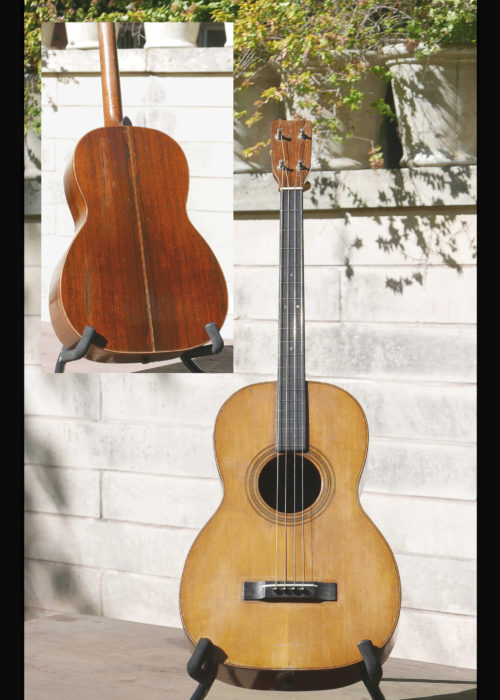 The 5-21 Martins, with their Brazilian Rosewood back and sides and Adirondack spruce tops, are known for putting out an astounding amount of sound. This tenor guitar, style 5-21T, does that in spades. Measuring 11-3/8" across, with its X braced top and light build, the instrument has an amazing amount of tone. Though Martin offered size 5 models ranging from style 15 through the elaborately ornamented style 45, the only ones made in any significant quantity prior to World War II were the style 17, 18, and 21 in six-string guitars and styles 17, 18, and 21 tenors, as well as some style 15 post-war size 5 tenors. Features of this instrument:
The 5-21 Martins, with their Brazilian Rosewood back and sides and Adirondack spruce tops, are known for putting out an astounding amount of sound. This tenor guitar, style 5-21T, does that in spades. Measuring 11-3/8" across, with its X braced top and light build, the instrument has an amazing amount of tone. Though Martin offered size 5 models ranging from style 15 through the elaborately ornamented style 45, the only ones made in any significant quantity prior to World War II were the style 17, 18, and 21 in six-string guitars and styles 17, 18, and 21 tenors, as well as some style 15 post-war size 5 tenors. Features of this instrument:- Recent neck set, and leveling of original bar frets, action is very good
- Original Grover tuning machines, working well
- Nut width of 1 1/4"
- Scale length: 22.5"
- 1 3/8" string spacing at the saddle
- Had an added tailpiece at once point (3 tiny screw holes near end pin
- No top cracks
- One repaired 11" crack on the bottom lower bout side
- One 6" repaired crack on the upper bout back under the herring bone center inlay,
- One 4” repaired crack on the lower bout back towards the bottom
- A small hole at the center of the rear headstock– probably at some point for a nail to hang the instrument on a wall
- Neck has a comfortable V shape, leaning toward a U profile
-
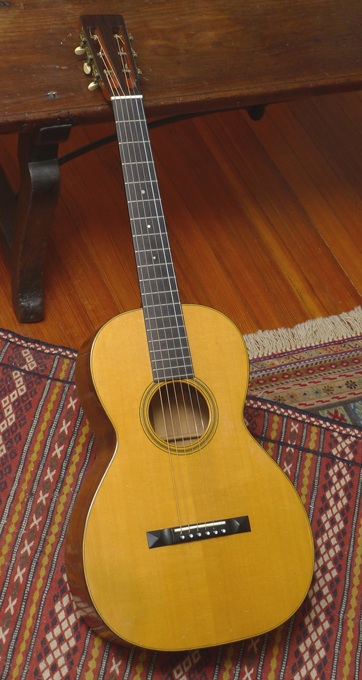 The grandson of Martin Guitar founder C. F. Martin, Sr., Frank Henry Martin suddenly found himself in control of the family business at the age of 22 when his father died in 1888 and left him unexpectedly in charge. The guitar market was still immature, and the young country was headed into an economic panic in the 1890's, but the young Frank Henry Martin quickly turned a traditional German business close to bankruptcy into a major force in the world of American music. Along with the young Frank Martin’s now legendary work ethic and marketing acumen, he is credited with personally revamping the Martin model line-up at the turn of the new century. Eschewing the trappings of an executive, he literally worked along side the shop craftsmen, day in and day out, six days a week. And he made the Style 18 the mainstay of the Martin catalog. This instrument is a living testament to that legacy– he personally signed this instrument, in cursive, under the top, on the fourth of February, 1907: “ 10381 2/4/07 F.H.M. ” Martin was still using Brazilian Rosewood for the back and sides for their 0-18 model in this 1907, and the tone of this instrument reflects all that is great about the combination of Brazilian back and sides, and Adirondack spruce (top), with a cedar neck, on the perennially great Size 0 Martin 12-fret, in all its Brazilian rosewood permutations through two centuries. This guitar is in remarkably original condition, and is completely crack-free. Just a few minor dings and superficial scratches. The finish is 100% original, with no touch-ups of any kind. The bar frets were replaced by us with period-correct bar frets–with material obtained from T.J. Thomson. (Several frets were missing, so we decided to replace all the frets.) Original ivory saddle, and bridge pins. Bridge has never been off the guitar. At some time in the past a neck set was done, so action is great, and the neck is straight. Original ebony nut is in the case. An ivory nut is installed on the guitar to accommodate silk & steel strings–which it does wonderfully. An Adirondack/Brazilian 12-fret 0-sized Martin over a century old yet in this kind of original condition, is very rare.
The grandson of Martin Guitar founder C. F. Martin, Sr., Frank Henry Martin suddenly found himself in control of the family business at the age of 22 when his father died in 1888 and left him unexpectedly in charge. The guitar market was still immature, and the young country was headed into an economic panic in the 1890's, but the young Frank Henry Martin quickly turned a traditional German business close to bankruptcy into a major force in the world of American music. Along with the young Frank Martin’s now legendary work ethic and marketing acumen, he is credited with personally revamping the Martin model line-up at the turn of the new century. Eschewing the trappings of an executive, he literally worked along side the shop craftsmen, day in and day out, six days a week. And he made the Style 18 the mainstay of the Martin catalog. This instrument is a living testament to that legacy– he personally signed this instrument, in cursive, under the top, on the fourth of February, 1907: “ 10381 2/4/07 F.H.M. ” Martin was still using Brazilian Rosewood for the back and sides for their 0-18 model in this 1907, and the tone of this instrument reflects all that is great about the combination of Brazilian back and sides, and Adirondack spruce (top), with a cedar neck, on the perennially great Size 0 Martin 12-fret, in all its Brazilian rosewood permutations through two centuries. This guitar is in remarkably original condition, and is completely crack-free. Just a few minor dings and superficial scratches. The finish is 100% original, with no touch-ups of any kind. The bar frets were replaced by us with period-correct bar frets–with material obtained from T.J. Thomson. (Several frets were missing, so we decided to replace all the frets.) Original ivory saddle, and bridge pins. Bridge has never been off the guitar. At some time in the past a neck set was done, so action is great, and the neck is straight. Original ebony nut is in the case. An ivory nut is installed on the guitar to accommodate silk & steel strings–which it does wonderfully. An Adirondack/Brazilian 12-fret 0-sized Martin over a century old yet in this kind of original condition, is very rare. -
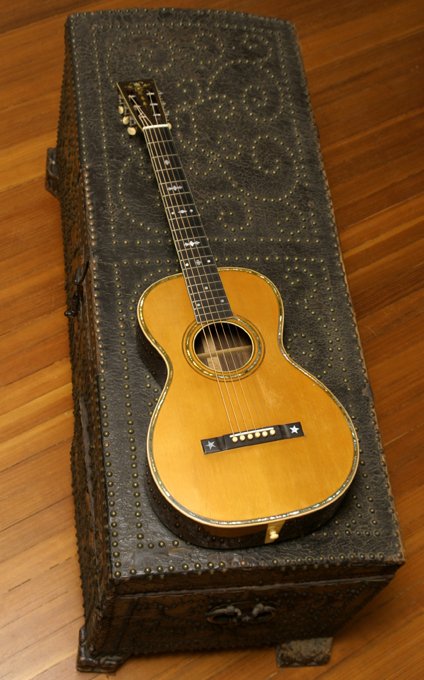 The Larson Brothers of Chicago began making steel string guitars earlier than did Martin, with their own ideas not tied to the past, and their designs are now considered by both players and collectors to be uniquely beautiful, wonderful for tone, and highly desirable. And they are much more rare guitars than Martin or Gibson– and more ornate than either Gibson or the always conservative Martin. Tone: think of a Martin Brazilian Rosewood 0-sized 12 fret from the 20’s, but add much more sustain. It vibrates in your hands, and because of Larson’s patented “built under tension” design, is thought of by players and collectors as being both unique and generating more sustain than you’ll get from any other guitar ever made. But the tone of Larsons (even the larger bodied-ones) is more treble-weighted than a Martin from the same era, so that this extra sustain does not result in a muddled sound– more like a magical shimmer and sustain that really brings out the mid- and treble-side Brazilian tone. Every part of this guitar is original. Guitar is crack-free. The bridge, never having been off the guitar, was at some point decades ago shaved slightly on top to lower the action. We have decided to keep this original bridge in place and not install a repro bridge–action is good, and the neck is straight. This particular model, is one of the very high end Larson models, with its Abalone trim, elaborate inlays on headstock and fretboard, and exquisite book-matched Brazilian rosewood back.
The Larson Brothers of Chicago began making steel string guitars earlier than did Martin, with their own ideas not tied to the past, and their designs are now considered by both players and collectors to be uniquely beautiful, wonderful for tone, and highly desirable. And they are much more rare guitars than Martin or Gibson– and more ornate than either Gibson or the always conservative Martin. Tone: think of a Martin Brazilian Rosewood 0-sized 12 fret from the 20’s, but add much more sustain. It vibrates in your hands, and because of Larson’s patented “built under tension” design, is thought of by players and collectors as being both unique and generating more sustain than you’ll get from any other guitar ever made. But the tone of Larsons (even the larger bodied-ones) is more treble-weighted than a Martin from the same era, so that this extra sustain does not result in a muddled sound– more like a magical shimmer and sustain that really brings out the mid- and treble-side Brazilian tone. Every part of this guitar is original. Guitar is crack-free. The bridge, never having been off the guitar, was at some point decades ago shaved slightly on top to lower the action. We have decided to keep this original bridge in place and not install a repro bridge–action is good, and the neck is straight. This particular model, is one of the very high end Larson models, with its Abalone trim, elaborate inlays on headstock and fretboard, and exquisite book-matched Brazilian rosewood back.- Year: 1926
- Model: 562
- Serial number: 31778
- This is the Maurer Larson Brothers “Standard size”: lower bout width: 12 3/4 inches
- Brazilian rosewood back and sides
- Spruce top
- Larson's “laminated” X braces. This is the patented Larson Brothers’ bracing, with each brace being Spruce/Rosewood/Spruce
- Larson’s patented “built under tension” design
- Trim: Abalone pearl and herringbone bordering the top and sound hole
- Torch-style pearl headstock inlay
- Radiused ebony fingerboard, and Classic Larson Brothers’ “ebony below the binding”
- Engraved inlays on fretboard
- Original Engraved Waverly tuners
- Original Ivory bridge pins
- 1-7/8" wide nut
- 2-5/16" bridge string spacing
- 24.5" scale length
- One-piece mahogany neck, round C shaped neck profile.
-
 The Larson Brothers of Chicago never marketed any guitar, throughout their long career, that was marked “Larson”. Their designs were branded by Maurer, Stahl, Prarie State, Stetson, and a few other guitar makers– but never “Larson”. They were also known for making many “off-catalog” guitars, i.e. guitars with combinations of features that varied from the Maurer, Stahl, etc, catalogs, and guitars that were not marked at all with a brand. This guitar is a Larson Bros creation that is not marked at all. It is a custom made instrument–but it has all the typical Larson hallmarks. The tone of this Larson is every bit as wonderful as the Maurer/Larson listed above, indeed it is quite similar, due to the same patented “built under tension” design, and X-bracing. This Larson does not have laminated braces (it’s well documented that laminated braces were only used on certain models–and their use was not related to level or price.) Every part of this guitar is original, including original finish. There are two repaired cracks on the back, and three small, repaired cracks on top.
The Larson Brothers of Chicago never marketed any guitar, throughout their long career, that was marked “Larson”. Their designs were branded by Maurer, Stahl, Prarie State, Stetson, and a few other guitar makers– but never “Larson”. They were also known for making many “off-catalog” guitars, i.e. guitars with combinations of features that varied from the Maurer, Stahl, etc, catalogs, and guitars that were not marked at all with a brand. This guitar is a Larson Bros creation that is not marked at all. It is a custom made instrument–but it has all the typical Larson hallmarks. The tone of this Larson is every bit as wonderful as the Maurer/Larson listed above, indeed it is quite similar, due to the same patented “built under tension” design, and X-bracing. This Larson does not have laminated braces (it’s well documented that laminated braces were only used on certain models–and their use was not related to level or price.) Every part of this guitar is original, including original finish. There are two repaired cracks on the back, and three small, repaired cracks on top.- Lower bout width: 12 5/8 inches
- Brazilian rosewood back and sides
- Ivory celluloid Bound fretboard
- Ivory celluloid Bound headstock
- Spruce top
- X braced
- Larson’s patented “built under tension” design
- Rosette: Abalone pearl and wood inlay bordering the sound hole
- Radiused ebony fingerboard, and Classic Larson Brothers’ “ebony below the binding”
- Engraved inlays on fretboard
- Original tuners
- Original ebony bridge
- Original bridge pins
- 1-7/8" wide nut
- 2 1/4" bridge string spacing
- 24.3" scale length
- One-piece mahogany neck, round C shaped neck profile.
-
 Nothing sounds like a 30’s Gibson L-00. No longer a sleeper on the vintage guitar market–they are sought after by working musicians the world over¬–they are still under-rated on the collector market. These mid-size Gibsons are incredibly resonant. There is nothing like them, from Gibson, and the mid-size Adirondack spruce over mahogany Martins from the mid to late 30’s command more than twice the price. This L-00 from 1938 has the best tone of any of the 30’s L-00’s we’ve seen. You won’t believe its presence. Acquired by us from the family of the original owner in Austin, Texas, this guitar is a great example of the era when Gibson still had a production jump on Martin, and even its lower cost guitars were winning the marketing war at the trailing end of the depression. This L-00 had a re-spray of its burst in the early 60’s, so while not the original finish, it’s got the right look and feel of the 30’s, and plenty of mileage to make it more than convincing. The top and sides are completely crack-free, and there are only two small cracks on the back. One is not through the wood, and the other was expertly addressed by Tony Nobles with a small cleat. Tony also made a new perfect reproduction Brazilian Rosewood bridge. The bridge plate is original and in great condition. Original firestripe pickguard. Original nut. The non-original tuners on the instrument when we acquired it were replaced by us with klusons from the period. Tony also installed new T-frets. While we tend to specialize in vintage Martins, this one might change my mind.
Nothing sounds like a 30’s Gibson L-00. No longer a sleeper on the vintage guitar market–they are sought after by working musicians the world over¬–they are still under-rated on the collector market. These mid-size Gibsons are incredibly resonant. There is nothing like them, from Gibson, and the mid-size Adirondack spruce over mahogany Martins from the mid to late 30’s command more than twice the price. This L-00 from 1938 has the best tone of any of the 30’s L-00’s we’ve seen. You won’t believe its presence. Acquired by us from the family of the original owner in Austin, Texas, this guitar is a great example of the era when Gibson still had a production jump on Martin, and even its lower cost guitars were winning the marketing war at the trailing end of the depression. This L-00 had a re-spray of its burst in the early 60’s, so while not the original finish, it’s got the right look and feel of the 30’s, and plenty of mileage to make it more than convincing. The top and sides are completely crack-free, and there are only two small cracks on the back. One is not through the wood, and the other was expertly addressed by Tony Nobles with a small cleat. Tony also made a new perfect reproduction Brazilian Rosewood bridge. The bridge plate is original and in great condition. Original firestripe pickguard. Original nut. The non-original tuners on the instrument when we acquired it were replaced by us with klusons from the period. Tony also installed new T-frets. While we tend to specialize in vintage Martins, this one might change my mind. -
 Another Gibson L-00, with great tone and volume, and all original finish. The top and sides are completely crack-free, and there are several small dryness cracks on the back. The bridge is original, and has never been off the guitar. We just set the neck, and installed a new bone saddle. The bridge plate is original and in perfect condition. Original firestripe pickguard. Original nut. Original frets.
Another Gibson L-00, with great tone and volume, and all original finish. The top and sides are completely crack-free, and there are several small dryness cracks on the back. The bridge is original, and has never been off the guitar. We just set the neck, and installed a new bone saddle. The bridge plate is original and in perfect condition. Original firestripe pickguard. Original nut. Original frets. -
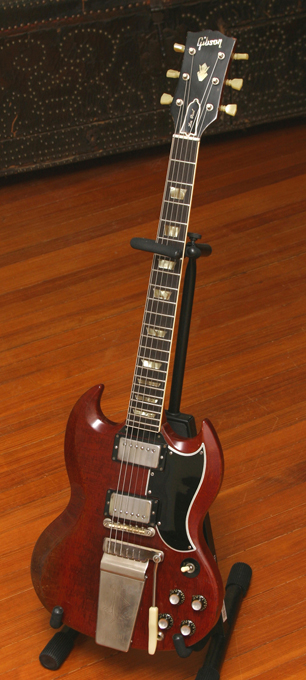 1963 and 1964 were the best years for the legendary early 60's Gibson SG. And 63-64 saw the transition from the Les Paul model to the "Solid Guitar" or SG. Only in 63 and 64 did Gibson use a particularly wide neck on the SG, and that's why players love SG's from these two seminal years. This '64 SG is something of a transition model from the last of the double cutaway Les Paul/SG's to the SG Standard-it carries the Les Paul truss rod cover (original to the guitar), and it features the great lyre vibrola (nickel). This 1964 SG, with all original finish, and original parts (including Patent # humbuckers), is a wonderful instrument with the right amount of honest wear to make it fit like a glove, and play like a dream in your left hand with that wonderful ample neck.
1963 and 1964 were the best years for the legendary early 60's Gibson SG. And 63-64 saw the transition from the Les Paul model to the "Solid Guitar" or SG. Only in 63 and 64 did Gibson use a particularly wide neck on the SG, and that's why players love SG's from these two seminal years. This '64 SG is something of a transition model from the last of the double cutaway Les Paul/SG's to the SG Standard-it carries the Les Paul truss rod cover (original to the guitar), and it features the great lyre vibrola (nickel). This 1964 SG, with all original finish, and original parts (including Patent # humbuckers), is a wonderful instrument with the right amount of honest wear to make it fit like a glove, and play like a dream in your left hand with that wonderful ample neck. -
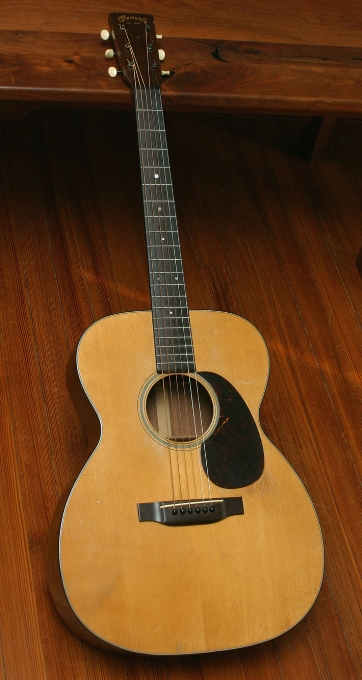 A rare, 100% original pre-war Martin. Not a crack anywhere. And though it of course has the 1-11/16 inch nut, it plays remarkably like the wider nut mid-30's 000-18's due to the generous (original) string spacing at the nut. Original finish. Neck has never been re-set. Original Ebony nut, ivory saddle, full height original bridge. Original tuners. Original plastic tuner buttons in great condition (no shrinkage). Lack of tuner ferrels of course (because of war-time metal shortages). Brazilian rosewood bridge, fingerboard, and peghead veneer. Scalloped braces. Original bridge plate. Frets show minor/normal wear. It shows light/normal pick wear around the soundhole (nothing anywhere near down to bare wood). Other minor superficial scratches on back, and sides. Bass tone and volume is impressive-the characteristic of war-time "pre-war" Martins, that featured more deeply scalloped braces. Many believe these more deeply scalloped braces found only in these years give them better tone than the mid-30s Martins. It does need a standard neck set. It's not egregiously out of set, action is a bit high at 12th fret. But due the originality of the instrument, original ivory saddle still hide glued-in, etc., we believe the buyer would want to set the neck to their liking. (We would be happy to set the neck for the new owner if desired, at no additional charge, after purchase.) The tone: gold standard pre-war 000-18. Loud, dark, crisp, and clear.
A rare, 100% original pre-war Martin. Not a crack anywhere. And though it of course has the 1-11/16 inch nut, it plays remarkably like the wider nut mid-30's 000-18's due to the generous (original) string spacing at the nut. Original finish. Neck has never been re-set. Original Ebony nut, ivory saddle, full height original bridge. Original tuners. Original plastic tuner buttons in great condition (no shrinkage). Lack of tuner ferrels of course (because of war-time metal shortages). Brazilian rosewood bridge, fingerboard, and peghead veneer. Scalloped braces. Original bridge plate. Frets show minor/normal wear. It shows light/normal pick wear around the soundhole (nothing anywhere near down to bare wood). Other minor superficial scratches on back, and sides. Bass tone and volume is impressive-the characteristic of war-time "pre-war" Martins, that featured more deeply scalloped braces. Many believe these more deeply scalloped braces found only in these years give them better tone than the mid-30s Martins. It does need a standard neck set. It's not egregiously out of set, action is a bit high at 12th fret. But due the originality of the instrument, original ivory saddle still hide glued-in, etc., we believe the buyer would want to set the neck to their liking. (We would be happy to set the neck for the new owner if desired, at no additional charge, after purchase.) The tone: gold standard pre-war 000-18. Loud, dark, crisp, and clear. -
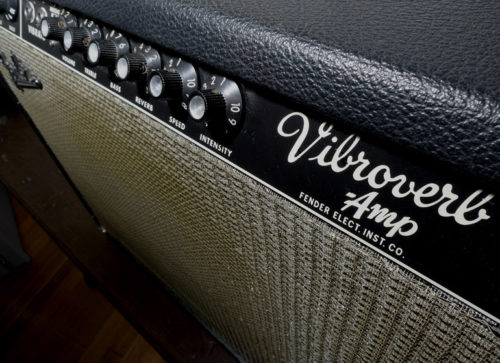 The blackface Vibroverb may be the most sought after Fender amp of all time. Stevie Ray Vaughan is famous for using them. The Vibroverb started as a 2x10 combo with reverb in '63. Then in late '63, Fender decided to switch to a 1x15. This amp has incredible tone. One must hear a black face circuit through an open cabinet JBL 15" speaker to understand the sound. It sounds big and can fill the hall, but it can work as a mid size amp perfect for gigs. This amp is versatile, since the JBL D130 can carry the treble of a telecaster or strat while still having a strong bottom end. Most other amps are either good on highs (Vibrolux, Princeton, Champ), good on lows (Twin, Showman), midrangy (Deluxe, and most new amps) or too big (Marshall double stack). The great Vibroverb is superior to them all. This 1964 Blackface Vibroverb has the original JBL speaker, and the original transformer. The amp also comes with its original footswitch. The only thing done to the amp has been replaced tubes, and the caps. The power cord has been replaced with a grounded three-prong cord.
The blackface Vibroverb may be the most sought after Fender amp of all time. Stevie Ray Vaughan is famous for using them. The Vibroverb started as a 2x10 combo with reverb in '63. Then in late '63, Fender decided to switch to a 1x15. This amp has incredible tone. One must hear a black face circuit through an open cabinet JBL 15" speaker to understand the sound. It sounds big and can fill the hall, but it can work as a mid size amp perfect for gigs. This amp is versatile, since the JBL D130 can carry the treble of a telecaster or strat while still having a strong bottom end. Most other amps are either good on highs (Vibrolux, Princeton, Champ), good on lows (Twin, Showman), midrangy (Deluxe, and most new amps) or too big (Marshall double stack). The great Vibroverb is superior to them all. This 1964 Blackface Vibroverb has the original JBL speaker, and the original transformer. The amp also comes with its original footswitch. The only thing done to the amp has been replaced tubes, and the caps. The power cord has been replaced with a grounded three-prong cord. -
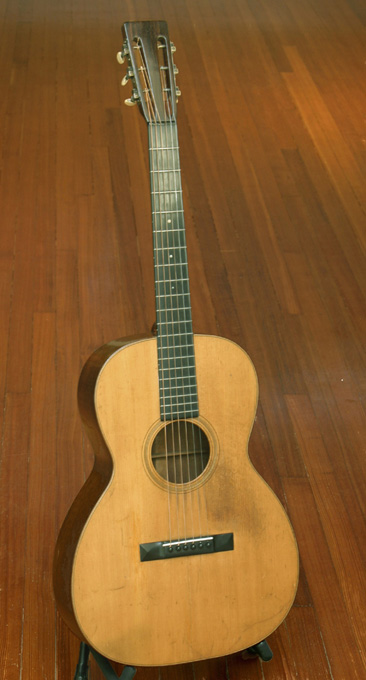 Take Martin’s best era for 12-fret guitars, add more scale length, and you get the best of both worlds–that’s what players say about the 000 sized 12-frets, if they can find one, from the mid to late 20’s. This was the biggest, loudest Martin made for steel strings in this era, with a 25.4 inch scale length, the same scale length as a 30’s D-45! (The 14-fret 000’s of the 30s and later have a shorter, 24.5 inch scale). In no other instrument will you get the resonance (from thin tops and back), combined with the long scale length. It’s a big pre-war Martin 12-fret. That’s why this instrument is a highly sought-after prewar Martin. This crack-free 000-18 has great provenance: acquired from and set up by one of the world’s top Martin experts (in Tuebingen, Germany). 1 7/8” nut. Mahogany back and sides. Adirondack spruce top. Ebony fingerboard. It has original tuners (gear wheel below worm gear, ivoroid buttons), parts, and all original finish. Restoration by TJ Thompson and Dana Bourgeois: correct replacement bridge (ebony pyramid) and bridge plate (maple), and frets replaced (bar frets). Center seam repaired and cleated and touched up (shellack). Neck has been reset. Neck is dead straight, bridge saddle is medium height (allows set up for both higher and lower action if needed in future). Low action, and set up for light or medium gauge strings. The tone could not be better: all the clear separation of the mids that is the hallmark of the 20’s style 18 twelve-fret, but with fuller, louder, rounder bass. One of the most sought-after Martin 12-frets, original finish, crack-free. Restored correctly, cared for, and set up by the world’s best luthiers and vintage Martin experts, and ready to enjoy.
Take Martin’s best era for 12-fret guitars, add more scale length, and you get the best of both worlds–that’s what players say about the 000 sized 12-frets, if they can find one, from the mid to late 20’s. This was the biggest, loudest Martin made for steel strings in this era, with a 25.4 inch scale length, the same scale length as a 30’s D-45! (The 14-fret 000’s of the 30s and later have a shorter, 24.5 inch scale). In no other instrument will you get the resonance (from thin tops and back), combined with the long scale length. It’s a big pre-war Martin 12-fret. That’s why this instrument is a highly sought-after prewar Martin. This crack-free 000-18 has great provenance: acquired from and set up by one of the world’s top Martin experts (in Tuebingen, Germany). 1 7/8” nut. Mahogany back and sides. Adirondack spruce top. Ebony fingerboard. It has original tuners (gear wheel below worm gear, ivoroid buttons), parts, and all original finish. Restoration by TJ Thompson and Dana Bourgeois: correct replacement bridge (ebony pyramid) and bridge plate (maple), and frets replaced (bar frets). Center seam repaired and cleated and touched up (shellack). Neck has been reset. Neck is dead straight, bridge saddle is medium height (allows set up for both higher and lower action if needed in future). Low action, and set up for light or medium gauge strings. The tone could not be better: all the clear separation of the mids that is the hallmark of the 20’s style 18 twelve-fret, but with fuller, louder, rounder bass. One of the most sought-after Martin 12-frets, original finish, crack-free. Restored correctly, cared for, and set up by the world’s best luthiers and vintage Martin experts, and ready to enjoy. -
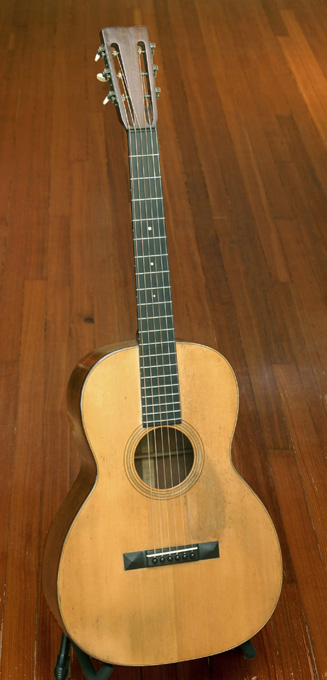 A steel-string braced 00-18, with finely scalloped braces, and light as a feather. No wonder the tone is exquisite. This 12-fret gem, from the best era for Martin12-frets, resonates in your hands (say what you want about the 30’s, but the more lightly-built Martins of the 20’s become an extension of your body). The set up is low (4 to 5 64ths), so it plays like a dream. Original finish throughout. Mahogany back and sides. Adirondack spruce top. Ebony fingerboard. Original tuners/gear wheel below worm gear, ivoroid buttons. The instrument was acquired from one of North America’s top Martin restoration shops, Folkway Music, who reported: “This 00-18 went back to Martin in the late 80's for a neck reset, refret, re-bridge, and a new bridge plate. The back has one repaired crack, and there are two well repaired side cracks. Martin's repairs are well done, the new bar frets are nice and tall, and the bridge plate (maple) is only slightly oversized. The somewhat oversized pyramid bridge didn't look great when the guitar came in, so we re-profiled it here in shop and fitted a new bone saddle and vintage-correct bridge-pins.” This instrument will not disappoint. It has been correctly and meticulously restored by Martin, and by one of the world’s top Martin experts. It’s ready for decades of enjoyment.
A steel-string braced 00-18, with finely scalloped braces, and light as a feather. No wonder the tone is exquisite. This 12-fret gem, from the best era for Martin12-frets, resonates in your hands (say what you want about the 30’s, but the more lightly-built Martins of the 20’s become an extension of your body). The set up is low (4 to 5 64ths), so it plays like a dream. Original finish throughout. Mahogany back and sides. Adirondack spruce top. Ebony fingerboard. Original tuners/gear wheel below worm gear, ivoroid buttons. The instrument was acquired from one of North America’s top Martin restoration shops, Folkway Music, who reported: “This 00-18 went back to Martin in the late 80's for a neck reset, refret, re-bridge, and a new bridge plate. The back has one repaired crack, and there are two well repaired side cracks. Martin's repairs are well done, the new bar frets are nice and tall, and the bridge plate (maple) is only slightly oversized. The somewhat oversized pyramid bridge didn't look great when the guitar came in, so we re-profiled it here in shop and fitted a new bone saddle and vintage-correct bridge-pins.” This instrument will not disappoint. It has been correctly and meticulously restored by Martin, and by one of the world’s top Martin experts. It’s ready for decades of enjoyment. -
 100% crack-free, structurally perfect, this 00-28 is gold standard for 12 fret, pre-war Martin Brazilian Rosewood tone. Refinished to exquisite standards some 40 years ago, this 00-28 has some of the most stunning Brazilian rosewood ever used by Martin. This is the most beautiful, best sounding "Herringbone" prewar 00-28 we've seen. And with mileage on the finish, at the Arlington Guitar Show last fall, several top vintage guitar dealers were not sure if this wasn't the original finish on the guitar, it's that good. It is braced for steel strings. It has held steel strings for years, and not only are there no cracks or stress issues, there is no bellying behind the bridge. And if that’s not enough, there is a letter from Mike Longworth, signed by Longworth and dated 1984, documenting the guitar, and suggesting the use of steel strings on it. Condition:
100% crack-free, structurally perfect, this 00-28 is gold standard for 12 fret, pre-war Martin Brazilian Rosewood tone. Refinished to exquisite standards some 40 years ago, this 00-28 has some of the most stunning Brazilian rosewood ever used by Martin. This is the most beautiful, best sounding "Herringbone" prewar 00-28 we've seen. And with mileage on the finish, at the Arlington Guitar Show last fall, several top vintage guitar dealers were not sure if this wasn't the original finish on the guitar, it's that good. It is braced for steel strings. It has held steel strings for years, and not only are there no cracks or stress issues, there is no bellying behind the bridge. And if that’s not enough, there is a letter from Mike Longworth, signed by Longworth and dated 1984, documenting the guitar, and suggesting the use of steel strings on it. Condition:- No cracks anywhere.... Not a hint of a crack
- original bridge plate, in great condition
- original tuners
- original ivory bridge pins (the replacement bridge was made to accommodate these great original ivory bridge pins)
- Bridge is a perfect Brazilian Rosewood replacement, done by us, with old growth Brazilian.
- Saddle, and nut, carved from ivory (sourced by us, pre-CITES)
- Three very tiny screw holes above endpin from a previous tailpiece added and removed decades ago, were expertly filled by Tony Nobles–difficult to see more than a few inches away
- All the bar frets replaced by us (with Bar fret material from TJ Thomson), so it plays like a dream, with that full, cascading Brazilian tone that you'll only get from a fine 00-28
-
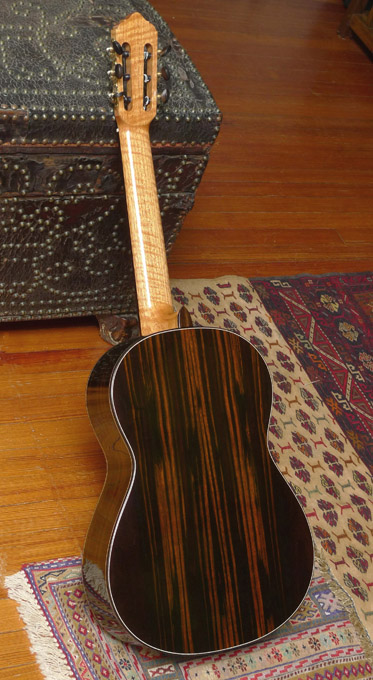 Vustom made Lester Devoe Flamenco Negra, a one-of-a-kind, Brazilian Rosewood guitar, from one of the world’s top luthiers. Lester Devoe needs no introduction to the world’s great Flamenco players. The late, legendary Sabicas played a Devoe– and converted some of the great Flamenco players in Spain to the fold. Paco De Lucia, and Vicente Amigo, among others, play Devoe Flamenco guitars. (I personally delivered a Devoe Flamenco Blanca guitar to Paco De Lucia in Spain in late 2010– Paco likes his Devoe’s hand-delivered. Paco De Lucia began playing a Devoe Negra guitar years ago– and there are many Paco De Lucia recordings and feature films where Paco plays a Devoe Flamenco guitar.) And it’s rare that Lester makes a Negra with Brazilian rosewood of this age and quality.
Vustom made Lester Devoe Flamenco Negra, a one-of-a-kind, Brazilian Rosewood guitar, from one of the world’s top luthiers. Lester Devoe needs no introduction to the world’s great Flamenco players. The late, legendary Sabicas played a Devoe– and converted some of the great Flamenco players in Spain to the fold. Paco De Lucia, and Vicente Amigo, among others, play Devoe Flamenco guitars. (I personally delivered a Devoe Flamenco Blanca guitar to Paco De Lucia in Spain in late 2010– Paco likes his Devoe’s hand-delivered. Paco De Lucia began playing a Devoe Negra guitar years ago– and there are many Paco De Lucia recordings and feature films where Paco plays a Devoe Flamenco guitar.) And it’s rare that Lester makes a Negra with Brazilian rosewood of this age and quality.- 650mm scale length
- Nut: 52mm
- Neck width at nut: 52mm
- String Spacing at nut: 44mm
- 80 year old Brazilian Rosewood (pre-CITES) back and sides (Quartersawn).
- European spruce top, with some beautiful and understated “"hazelfichte" (what Americans call bear claw).
- Custom, flamed Spanish Cedar neck
- Brazilian Rosewood headstock overlay, and bridge
- Brazilian Rosewood body binding, top and back
- Ebony fingerboard
- Sloane tuners
- Austere yet elegant Santos style black and white rosette, that Devoe uses only rarely, on top custom models
- Nitrocellulose lacquer finish
-
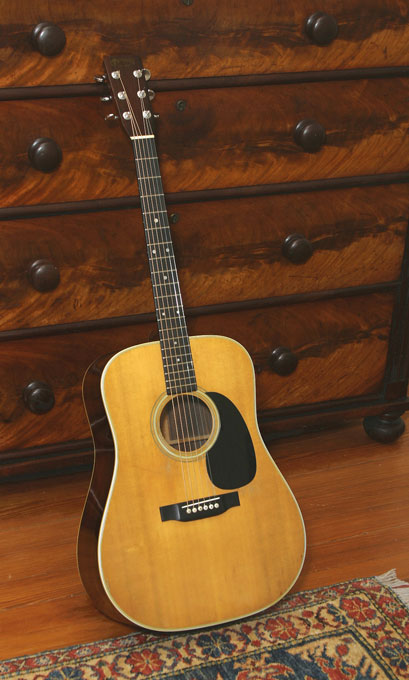 The last of the Mohicans, made within a few months before Martin stopped using Brazilian Rosewood on its instruments. Some guitars feel dead right the minute you pick them up. This is on of those. First and foremost, the tone of this instrument is unsurpassed for the bell-like trebles that only come from Brazilian Rosewood. The tone of this guitar, I would hold up to most mid-40’s D-28’s I’ve played. Playability, and set-up: it could not be better, and it’s got that 60’s combination of low action, great tuning speed and accuracy from the Grovers, and superb intonation all the way to the wee frets. More than anything, this guitar stands out for its low action combined with robust tone. Amazingly, the string height at the 12th fret: Just a hair over 2/32” at the high E; and 3/32 at the low E. It plays in our left hand like a dream, fast and fluid… yet the tone is full with no buzzing anywhere. I personally have never played a Martin dreadnought from any period that is so effortless to play, so easy on the left hand and so fast and yet so full of Brazilian tone. BTW, light gauge strings only? No way… I’ve got it strung with medium gauge, and it plays like butter in your left hand. Condition:
The last of the Mohicans, made within a few months before Martin stopped using Brazilian Rosewood on its instruments. Some guitars feel dead right the minute you pick them up. This is on of those. First and foremost, the tone of this instrument is unsurpassed for the bell-like trebles that only come from Brazilian Rosewood. The tone of this guitar, I would hold up to most mid-40’s D-28’s I’ve played. Playability, and set-up: it could not be better, and it’s got that 60’s combination of low action, great tuning speed and accuracy from the Grovers, and superb intonation all the way to the wee frets. More than anything, this guitar stands out for its low action combined with robust tone. Amazingly, the string height at the 12th fret: Just a hair over 2/32” at the high E; and 3/32 at the low E. It plays in our left hand like a dream, fast and fluid… yet the tone is full with no buzzing anywhere. I personally have never played a Martin dreadnought from any period that is so effortless to play, so easy on the left hand and so fast and yet so full of Brazilian tone. BTW, light gauge strings only? No way… I’ve got it strung with medium gauge, and it plays like butter in your left hand. Condition:- all original: finish; frets bridge, bridge plate, saddle. (Bridge pins could be replacements, hard to tell, but they are right.)
- The bridge looks like it has never been off
- Neck has never been set
- There is minor pickwear, with some moderate wear around the soundhole.
- No cracks on top; two, almost indiscernible cracks on back, that have been addressed–glued (no cleats). You have to look very hard to see these two back cracks, they are hairline cracks, each about 6 inches long.. but they are not visible from more than a few inches away, and impossible to photograph.
- Minor nicks and dings, most are visible in photos
- No strap lugs ever added
- Original end pin
- Throw away the book on this one… This is one of the best Brazilian rosewood Dreadnought Martins you’ll play, period, in fine original condition.
-
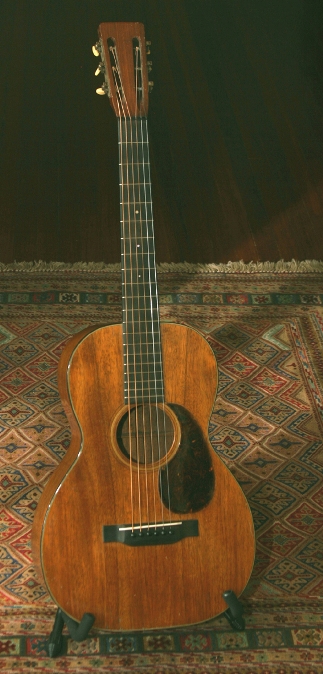 We converted this Golden Era 12-fret Koa Martin from the original Hawaiian setup ourselves, so it's perfect. The instrument does not have a crack anywhere. All original finish. Original Ebony bridge, converted from the tall Hawaiian set-up to a normal 30's set-up. Same with the ebony nut. All new, period-perfect Bar Frets. We radiused the ebony fretboard to 30's Martin specs. Neck was set and action is perfect. 1-7/8 inch nut width. Original tuners. Original bridge plate. Minor nicks and dings on top and back, but with the all original finish and crack-free, it's a rare specimen. Nothing compares in tone to an all-Koa Golden Age Martin. Koa blends the midrange of mahogany with the top end of maple-or, in the case of a fine 30's Koa Martin- hints of Brazilian rosewood. This fine 0-18K has all you would want from a Koa Martin, with the clearest, bell-like treble string tone imaginable.
We converted this Golden Era 12-fret Koa Martin from the original Hawaiian setup ourselves, so it's perfect. The instrument does not have a crack anywhere. All original finish. Original Ebony bridge, converted from the tall Hawaiian set-up to a normal 30's set-up. Same with the ebony nut. All new, period-perfect Bar Frets. We radiused the ebony fretboard to 30's Martin specs. Neck was set and action is perfect. 1-7/8 inch nut width. Original tuners. Original bridge plate. Minor nicks and dings on top and back, but with the all original finish and crack-free, it's a rare specimen. Nothing compares in tone to an all-Koa Golden Age Martin. Koa blends the midrange of mahogany with the top end of maple-or, in the case of a fine 30's Koa Martin- hints of Brazilian rosewood. This fine 0-18K has all you would want from a Koa Martin, with the clearest, bell-like treble string tone imaginable. -
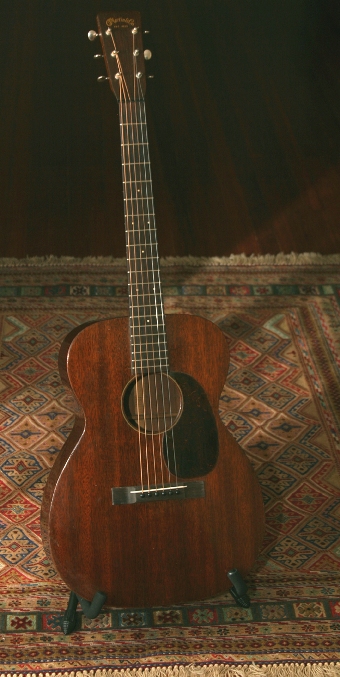 This model is something of a sleeper on the Golden Era Martin guitar market, because there are just not that many pre-1939 00-17s available. There are quite a few war-time and post-war 00-17s, but a 00-17 with full pre-war specs, forward shifted X-bracing, and 1 3/4 inch nut, is hard to come by–and they have all the great qualities of 00-sized Golden Era Martins that cost twice or three times the price on the vintage market–for now, as these great pre-war 00-17s will catch up quickly. The tone and volume of this 00-17 is astounding: full, amazingly bright, and with impressive volume. 1-3/4 inch nut width. Crack-free except for a well-repaired crack on bass side, about 2 inches long, that's difficult to see even up close. No cracks at all on top, or back. All original finish. Original bridge plate. This model has of course a mahogany top as well as mahogany back and sides. And with that dark look and original gloss finish that really sets this Golden Age Martin apart in its own class. Neck has the typically slightly beefier profile that's the hallmark of the best 30's 14-fret Martins. Neck was set by us. Replaced, period-correct Brazilian rosewood bridge. Original ebony nut. All new T-frets installed by us. Original tuners.
This model is something of a sleeper on the Golden Era Martin guitar market, because there are just not that many pre-1939 00-17s available. There are quite a few war-time and post-war 00-17s, but a 00-17 with full pre-war specs, forward shifted X-bracing, and 1 3/4 inch nut, is hard to come by–and they have all the great qualities of 00-sized Golden Era Martins that cost twice or three times the price on the vintage market–for now, as these great pre-war 00-17s will catch up quickly. The tone and volume of this 00-17 is astounding: full, amazingly bright, and with impressive volume. 1-3/4 inch nut width. Crack-free except for a well-repaired crack on bass side, about 2 inches long, that's difficult to see even up close. No cracks at all on top, or back. All original finish. Original bridge plate. This model has of course a mahogany top as well as mahogany back and sides. And with that dark look and original gloss finish that really sets this Golden Age Martin apart in its own class. Neck has the typically slightly beefier profile that's the hallmark of the best 30's 14-fret Martins. Neck was set by us. Replaced, period-correct Brazilian rosewood bridge. Original ebony nut. All new T-frets installed by us. Original tuners. -
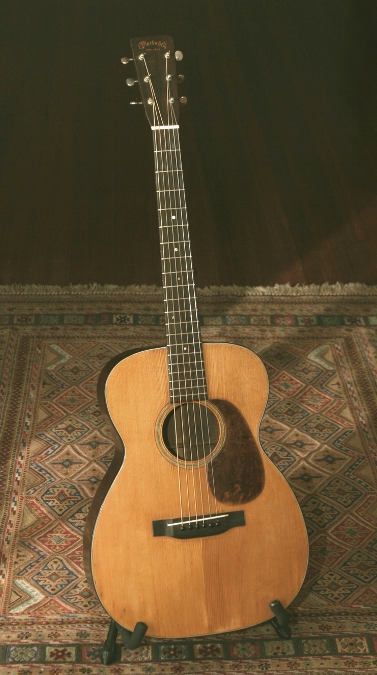 Probably the best year ever for 14-fret 00-18s. In the Golden Age of 14-fret Martins from the early 30's until the late 30's, only in 1936 did Martin use Brazilian rosewood (as opposed to ebony) for the fretboard and bridges of 18's, so its tone is considered by many to be the best in the 14 fret, 1-3/4 inch nut era. The guitar is crack-free on the top and back. Just one repaired crack on the treble side.The repair is well done and almost impossible to see from the outside (older repair has muslin cloth on inside-luthiers agree that these older cloth patches inside a vintage Martin should be left in place). Original tuners. Original bridge plate. Original nut. Replaced T-frets by us. Replacement bridge-very dark Brazilian rosewood bridge made to original specs in our shop, and ivory saddle. The neck has that wonderful mid-thirties slightly fatter profile. Neck set by us. And the tone is the best example of a Golden Era 00-18 you'll find anywhere. Light overspray (no refinishing) on back and sides (not top, neck or head).
Probably the best year ever for 14-fret 00-18s. In the Golden Age of 14-fret Martins from the early 30's until the late 30's, only in 1936 did Martin use Brazilian rosewood (as opposed to ebony) for the fretboard and bridges of 18's, so its tone is considered by many to be the best in the 14 fret, 1-3/4 inch nut era. The guitar is crack-free on the top and back. Just one repaired crack on the treble side.The repair is well done and almost impossible to see from the outside (older repair has muslin cloth on inside-luthiers agree that these older cloth patches inside a vintage Martin should be left in place). Original tuners. Original bridge plate. Original nut. Replaced T-frets by us. Replacement bridge-very dark Brazilian rosewood bridge made to original specs in our shop, and ivory saddle. The neck has that wonderful mid-thirties slightly fatter profile. Neck set by us. And the tone is the best example of a Golden Era 00-18 you'll find anywhere. Light overspray (no refinishing) on back and sides (not top, neck or head). -
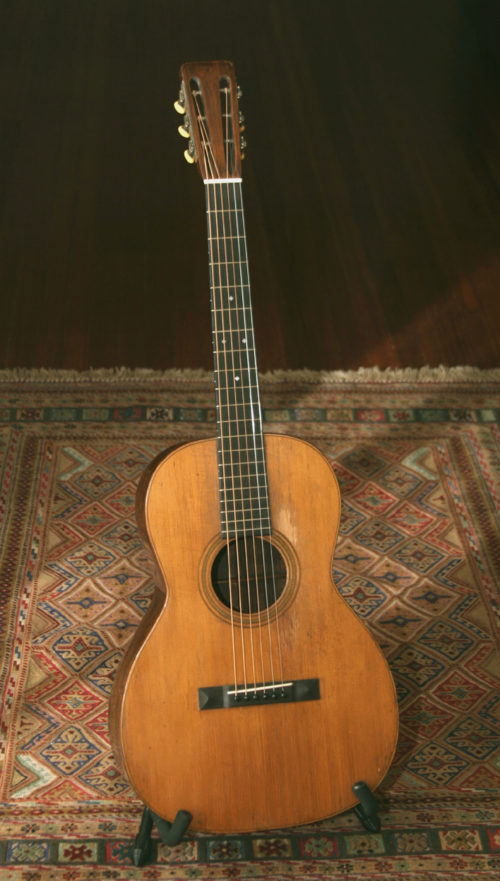 This big 12-fret Brazilian Rosewood pre-war Martin is properly set up for steel strings, with new replacement ebony pyramid bridge meticulously made to original specs, but compensated for steel string, perfect intonation. All braces original and in great shape. Original bridge plate. All original finish everywhere. This guitar has all the tone you'd expect from a pre-war 00 Brazilian Martin. It's had restoration work, all by us, recently, as follows. Hide glue used in all repairs/restoration.
This big 12-fret Brazilian Rosewood pre-war Martin is properly set up for steel strings, with new replacement ebony pyramid bridge meticulously made to original specs, but compensated for steel string, perfect intonation. All braces original and in great shape. Original bridge plate. All original finish everywhere. This guitar has all the tone you'd expect from a pre-war 00 Brazilian Martin. It's had restoration work, all by us, recently, as follows. Hide glue used in all repairs/restoration.- Several cracks in sides, back, and top professionally repaired (5 or 6 cracks overall)
- Small hole drilled in top of headstock many decades ago (to hang the guitar on a wall presumably) has been expertly filled and finished with a piece of Brazilian rosewood veneer, on front, to match the veneer of the headstock.
- Neck set.
- New replacement ebony pyramid bridge meticulously made to original specs, but compensated to steel string intonation. Scratch marks in spruce top, on either side of bridge, filled and finished.
- All new, replacement Bar Frets
- To the thin maple, original bridge plate, we carefully added tiny maple ring/plugs, with hide glue, into the holes, to address bridge pins holes slightly enlarged over the years.
- Older repaired small crack in heel expertly touched up. It's 100% stable. (It appears to be a surface/finish crack.) It's very hard to see even up close, and impossible to photograph.
-
 The instrument features the original ebony bridge (full height), original tuners, original ivory saddle and nut, original maple bridge plate. Ebony fretboard. Bar frets. Thin, Soft-V neck. Finish is original. There is some overspray on the top, which is confined mainly to below the soundhole (over about the same size area, as what a pickguard would cover–but it never had a pickguard), and a bit below the bridge, and very very light on other areas of the top. Apparently a previous owner wanted to address the pick/finger wear and a repaired crack below the bridge. It's generally unobtrusive, no effect on the color of the top, and not noticeable from a few feet. Also, some light overspray on back and sides. As overspray goes, it has minimal effect on the appearance. Neck, and head have no overspray at all. There is one crack on the instrument from the bridge to the bottom of the guitar, but it's well repaired (it's about a half-inch from the center seam, below the bridge). Also about a 2 1/2 inch shallow crack/finish crack near where the fretboard meets the top (about 1/8 inch from the fretboard), on low-E side (does not go through–It is not visible on underside of top). There is a small indentation on the side rosewood (about one inch in area, on the side/lower, stable.) 1-7/8 inch nut. Action is 3/32 inch high E string/12th fret. 4/32 low E string… just right to get that full, cascading Brazilian tone from this fine 0-21.
The instrument features the original ebony bridge (full height), original tuners, original ivory saddle and nut, original maple bridge plate. Ebony fretboard. Bar frets. Thin, Soft-V neck. Finish is original. There is some overspray on the top, which is confined mainly to below the soundhole (over about the same size area, as what a pickguard would cover–but it never had a pickguard), and a bit below the bridge, and very very light on other areas of the top. Apparently a previous owner wanted to address the pick/finger wear and a repaired crack below the bridge. It's generally unobtrusive, no effect on the color of the top, and not noticeable from a few feet. Also, some light overspray on back and sides. As overspray goes, it has minimal effect on the appearance. Neck, and head have no overspray at all. There is one crack on the instrument from the bridge to the bottom of the guitar, but it's well repaired (it's about a half-inch from the center seam, below the bridge). Also about a 2 1/2 inch shallow crack/finish crack near where the fretboard meets the top (about 1/8 inch from the fretboard), on low-E side (does not go through–It is not visible on underside of top). There is a small indentation on the side rosewood (about one inch in area, on the side/lower, stable.) 1-7/8 inch nut. Action is 3/32 inch high E string/12th fret. 4/32 low E string… just right to get that full, cascading Brazilian tone from this fine 0-21. -
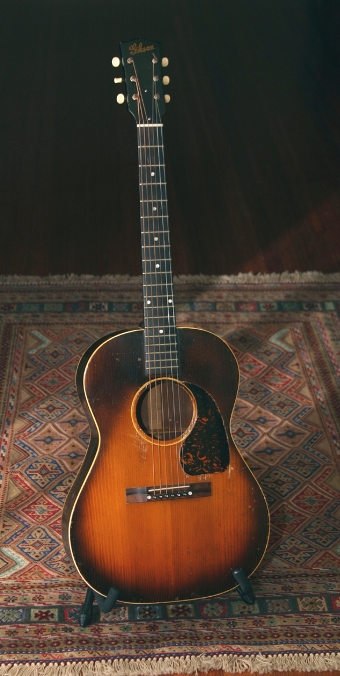 (No serial number or FON, these years often do not have one.) This completely crack-free, Script logo LG-2 is a jewel. A lot of players say the script logo Gibsons from right after the war are better sounding and better-built guitars than the Banner Gibsons. All of the good things about Banners, but with better craftsmanship. All original finish, everywhere. Mahogany back and sides. Spruce top. Not a crack anywhere. 1-3/4" nut. The bridge is an excellent quality rosewood replacement. Original maple plate. Original tuners. Replaced nut and saddle. Rosewood fingerboard shows moderate wear on first couple of frets. Some of that wonderful Gibson 40’s crazing to the finish, but not at all out of hand. Various pick marks, and dings. Original tuners, bridge, plate. Piezo pickup was skillfully de-installed, and endpin jack removed and plugged. One of the finest Script logo LG-2s you’ll find.
(No serial number or FON, these years often do not have one.) This completely crack-free, Script logo LG-2 is a jewel. A lot of players say the script logo Gibsons from right after the war are better sounding and better-built guitars than the Banner Gibsons. All of the good things about Banners, but with better craftsmanship. All original finish, everywhere. Mahogany back and sides. Spruce top. Not a crack anywhere. 1-3/4" nut. The bridge is an excellent quality rosewood replacement. Original maple plate. Original tuners. Replaced nut and saddle. Rosewood fingerboard shows moderate wear on first couple of frets. Some of that wonderful Gibson 40’s crazing to the finish, but not at all out of hand. Various pick marks, and dings. Original tuners, bridge, plate. Piezo pickup was skillfully de-installed, and endpin jack removed and plugged. One of the finest Script logo LG-2s you’ll find. -
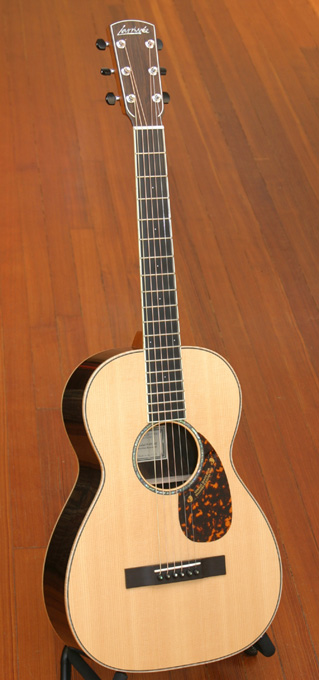 Mint condition. Period. Exceptional Larrivee 12-fret parlor guitar with a straight grained Sitka Spruce top and beautifully figured Brazilian Rosewood back & sides. Part of a very limited run of guitars built of high grade old stock Brazilian rosewood. Abalone rosette and tortoise shell pickguard. Ebony bridge w/ compensated saddle. Mahogany neck w/ microdot inlays, ivoroid bound ebony fingerboard, 1-3/4" nut, 24-1/4" scale, 13-1/4" lower bout, Larrivee logo peghead inlay, chrome tuners w/ebony buttons.
Mint condition. Period. Exceptional Larrivee 12-fret parlor guitar with a straight grained Sitka Spruce top and beautifully figured Brazilian Rosewood back & sides. Part of a very limited run of guitars built of high grade old stock Brazilian rosewood. Abalone rosette and tortoise shell pickguard. Ebony bridge w/ compensated saddle. Mahogany neck w/ microdot inlays, ivoroid bound ebony fingerboard, 1-3/4" nut, 24-1/4" scale, 13-1/4" lower bout, Larrivee logo peghead inlay, chrome tuners w/ebony buttons. -
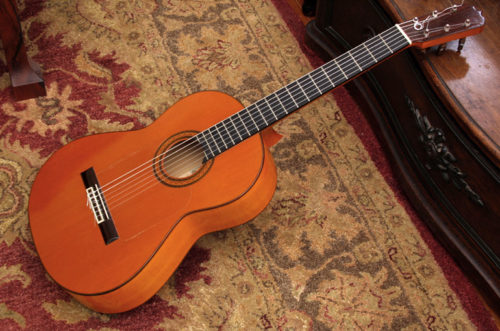 Martin established the X-brace as the standard in American guitars, but that was never pre-ordained, or set in stone. The fan-bracing of the Spanish guitar has equally appealing qualities, and is a century-plus long standard that continues to dominate the design of the classical and flamenco guitar. Not an “Estudio” (student) model, this is the top of line model, 1a Ramirez flamenco. If you’ve never played one of these exquisite cypress Ramirez flamenco guitars–you’ll be surprised at the tone. Spanish cypress back and sides. Cedar top. First of all, the guitar is so light. It floats in your hands, yet it’s tight as a drum. It’s one of the lightest guitars you will ever play (due to the lightness of the wood, and also to the use of tuning pegs–so that the head and neck of the guitar are not pulled down by gravity, allowing the head to float effortlessly at about eye level. And the raspy bass is unbelievable. It’s all about that percussive tone and throaty bass. Conventional wisdom says rosewood for a “classical” guitar, for sustain; and cypress for a flamenco guitar, for the percussive, throaty quality, and more volume. Action is low, as it should be for flamenco. And that wonderful wide nut (2-1/8 inch), you’ve got so much room to move on this beautiful ebony fingerboard. Original finish. As with almost all these old Ramirez flamencos with the tap plate on top, there are shallow, thin hairline cracks where the top edge, and bottom edge, of the tap plate (clear plastic) meets the top (similar to the small cracks you get on an old martin, due to the guard being glued to the top). There is also a six-inch long hairline finish crack on the top above and parallel to the fingerboard (does not go through the wood), and a 3-inch long hairline finish crack below the fingerboard. A few dings here and there, but finish is that original, beautiful high polish reddish-amber.
Martin established the X-brace as the standard in American guitars, but that was never pre-ordained, or set in stone. The fan-bracing of the Spanish guitar has equally appealing qualities, and is a century-plus long standard that continues to dominate the design of the classical and flamenco guitar. Not an “Estudio” (student) model, this is the top of line model, 1a Ramirez flamenco. If you’ve never played one of these exquisite cypress Ramirez flamenco guitars–you’ll be surprised at the tone. Spanish cypress back and sides. Cedar top. First of all, the guitar is so light. It floats in your hands, yet it’s tight as a drum. It’s one of the lightest guitars you will ever play (due to the lightness of the wood, and also to the use of tuning pegs–so that the head and neck of the guitar are not pulled down by gravity, allowing the head to float effortlessly at about eye level. And the raspy bass is unbelievable. It’s all about that percussive tone and throaty bass. Conventional wisdom says rosewood for a “classical” guitar, for sustain; and cypress for a flamenco guitar, for the percussive, throaty quality, and more volume. Action is low, as it should be for flamenco. And that wonderful wide nut (2-1/8 inch), you’ve got so much room to move on this beautiful ebony fingerboard. Original finish. As with almost all these old Ramirez flamencos with the tap plate on top, there are shallow, thin hairline cracks where the top edge, and bottom edge, of the tap plate (clear plastic) meets the top (similar to the small cracks you get on an old martin, due to the guard being glued to the top). There is also a six-inch long hairline finish crack on the top above and parallel to the fingerboard (does not go through the wood), and a 3-inch long hairline finish crack below the fingerboard. A few dings here and there, but finish is that original, beautiful high polish reddish-amber. -
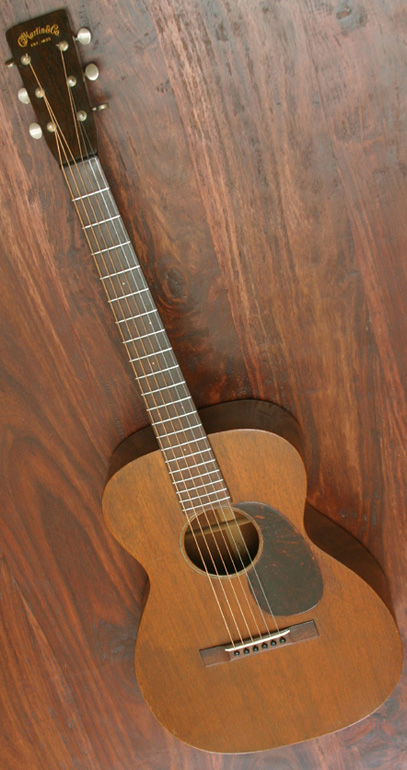 It’s rare to find a Golden Era Martin in this condition. This wonderful, completely crack-free 14-fret guitar from the 30’s is a gem. It’s one of the very first Martins of any style to have all three: 14 frets clear of body+Martin decal on the front of the peghead+Martin stamp the back of the peghead. Mahogany top, back and sides, of course, and it has the great, resonant feel and tone of a very lightly built 12-fret, but with more volume, in a 14-fret package. Strong bass response. 1 3/4 inch nut. Original finish, everywhere; no cracks anywhere. Original tuners. Original full-height bridge and maple bridge plate. Original bridge pins, and nut. The neck was recently set, so there is a new bone saddle, and the action is nice and low. Original bar frets. Some slight wear below the pick guard (not a hint of a crack or even any shrinking of the edges of the pick guard), and a variety of minor dings– but this completely crack-free guitar from the Martin Golden era is a gem.
It’s rare to find a Golden Era Martin in this condition. This wonderful, completely crack-free 14-fret guitar from the 30’s is a gem. It’s one of the very first Martins of any style to have all three: 14 frets clear of body+Martin decal on the front of the peghead+Martin stamp the back of the peghead. Mahogany top, back and sides, of course, and it has the great, resonant feel and tone of a very lightly built 12-fret, but with more volume, in a 14-fret package. Strong bass response. 1 3/4 inch nut. Original finish, everywhere; no cracks anywhere. Original tuners. Original full-height bridge and maple bridge plate. Original bridge pins, and nut. The neck was recently set, so there is a new bone saddle, and the action is nice and low. Original bar frets. Some slight wear below the pick guard (not a hint of a crack or even any shrinking of the edges of the pick guard), and a variety of minor dings– but this completely crack-free guitar from the Martin Golden era is a gem. -
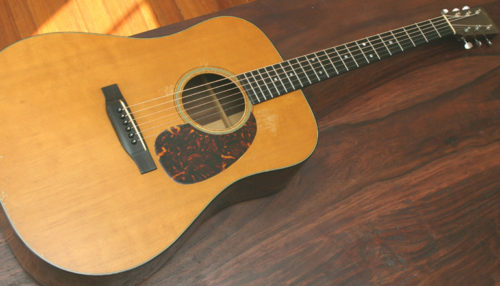 This big booming dreadnaught from one of Martin’s finest eras has everything you’d expect in volume, but it also has that wonderful sustain and ringing treble, and warm round bass, that only an almost-50-year-old Brazilian Rosewood Martin dreadnaught brings. All original throughout. Small 3 inch finish crack on lower back, stable. Typical B-string/pickguard crack, difficult to see, from bridge to beneath guard. Great original finish with minor dings and some minor pickwear around the soundhole. Ivory nut, full, original bridge and perfect condition maple bridge plate. The frets are in great condition. Rosewood fingerboard shows slight wear, nothing out of the ordinary. Frets are fine, showing minimal wear. Beautiful tortoiseshell binding in great condition, no separation anywhere. Inside of guitar shows all braces perfect–very clean and dust-free inside. Strap lug on heel and endpin. The neck was just set by Tony Nobles, and the action is low, with no buzzing. You can play it hard. It was fitted with a new bone saddle with the neck set (the original ivory saddle is in the case). Brazilian rosewood D-size Martins, from the era when Martin still used hide glue for guitar construction, are highly sought-after. This one, in this condition, will go quickly.
This big booming dreadnaught from one of Martin’s finest eras has everything you’d expect in volume, but it also has that wonderful sustain and ringing treble, and warm round bass, that only an almost-50-year-old Brazilian Rosewood Martin dreadnaught brings. All original throughout. Small 3 inch finish crack on lower back, stable. Typical B-string/pickguard crack, difficult to see, from bridge to beneath guard. Great original finish with minor dings and some minor pickwear around the soundhole. Ivory nut, full, original bridge and perfect condition maple bridge plate. The frets are in great condition. Rosewood fingerboard shows slight wear, nothing out of the ordinary. Frets are fine, showing minimal wear. Beautiful tortoiseshell binding in great condition, no separation anywhere. Inside of guitar shows all braces perfect–very clean and dust-free inside. Strap lug on heel and endpin. The neck was just set by Tony Nobles, and the action is low, with no buzzing. You can play it hard. It was fitted with a new bone saddle with the neck set (the original ivory saddle is in the case). Brazilian rosewood D-size Martins, from the era when Martin still used hide glue for guitar construction, are highly sought-after. This one, in this condition, will go quickly. -
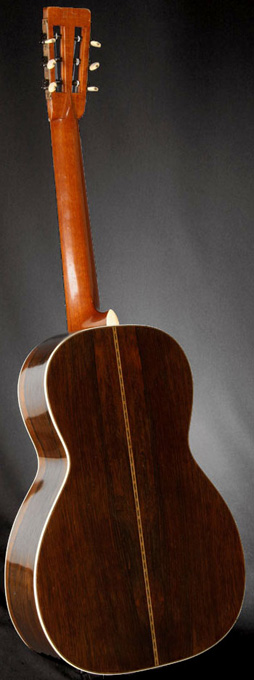 Signed by Martin factory foreman, underside of top: “6/1886”, this 0-28 is in stunning original condition. 1886 is the last year of the original factory in Nazareth, before Martin built the new factory addition in 1887. It is also the last year before they installed mechanized steam-run equipment to bend sides. So this wonderful 0-28, is one of the last of the totally hand-crafted Martins, built without mechanized equipment, and signed as such, 1886. Instrument is 100% original: finish, bridge, ivory nut, ivory saddle, ivory pins, bar frets, everything.
Signed by Martin factory foreman, underside of top: “6/1886”, this 0-28 is in stunning original condition. 1886 is the last year of the original factory in Nazareth, before Martin built the new factory addition in 1887. It is also the last year before they installed mechanized steam-run equipment to bend sides. So this wonderful 0-28, is one of the last of the totally hand-crafted Martins, built without mechanized equipment, and signed as such, 1886. Instrument is 100% original: finish, bridge, ivory nut, ivory saddle, ivory pins, bar frets, everything.- Crack-free
- repaired center seam on top
- Shows very little wear
- Scalloped braces (X-braced)
- original maple bridge plate
- original French-polish shellac finish throughout
- 13.5" wide at lower bout, and 4.25" deep at the endpin
- 24.9" scale length
- 1-7/8" wide nut
- soft-V neck profile.
-
 This fine Brazilian Rosewood 12-fret Martin is a joy to play, and it’s properly set up for steel strings. The grandson of C. F. Martin, Sr., Frank Henry Martin oversaw the Martin business from 1880 until well into twentieth century, and was responsible for the creation of the Style 0. I’m sure he loved this guitar–he personally signed the instrument, in cursive, under the top: “# 10082 Oct. 17th, 1905 F.H.M.” This 0-21 combines the exquisite tone of a 100 year old Martin, with some wonderful restoration. Guitar was refinished, probably decades ago, and it is a beautiful, French polish finish that has all the earmarks of an original finish. You can see the pores and saw marks in the Brazilian rosewood. No heavy-handed finish here, it’s a natural finish that lets the grain and color of the wood come through. And the tone, too, that sweet tone you can only get from Brazilian this old. The ebony pyramid bridge is a replacement, and features a compensated saddle, so intonation is dead on. (The bridge plate is the original small maple plate, in perfect condition.) Original tuners. Crack-free top and sides. There is only one very small crack, on the back, about 3 inches long, professionally repaired. The neck was set recently by Tony Nobles, and the original bar frets dressed. It plays, and sounds, like a late 20’s 12-fret Brazilian rosewood Martin.
This fine Brazilian Rosewood 12-fret Martin is a joy to play, and it’s properly set up for steel strings. The grandson of C. F. Martin, Sr., Frank Henry Martin oversaw the Martin business from 1880 until well into twentieth century, and was responsible for the creation of the Style 0. I’m sure he loved this guitar–he personally signed the instrument, in cursive, under the top: “# 10082 Oct. 17th, 1905 F.H.M.” This 0-21 combines the exquisite tone of a 100 year old Martin, with some wonderful restoration. Guitar was refinished, probably decades ago, and it is a beautiful, French polish finish that has all the earmarks of an original finish. You can see the pores and saw marks in the Brazilian rosewood. No heavy-handed finish here, it’s a natural finish that lets the grain and color of the wood come through. And the tone, too, that sweet tone you can only get from Brazilian this old. The ebony pyramid bridge is a replacement, and features a compensated saddle, so intonation is dead on. (The bridge plate is the original small maple plate, in perfect condition.) Original tuners. Crack-free top and sides. There is only one very small crack, on the back, about 3 inches long, professionally repaired. The neck was set recently by Tony Nobles, and the original bar frets dressed. It plays, and sounds, like a late 20’s 12-fret Brazilian rosewood Martin. -
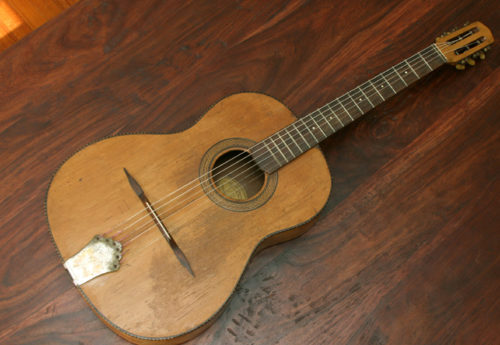 When Martin entered into its “Golden Age” for the flat top guitar, the jazz guitar was evolving on a parallel and equally important track. And in Europe, especially France, they had their own ideas about guitar making, and produced some brilliant guitars in this era–including of course the wonderful Selmer gypsy jazz guitar. The brothers Gerome were among the best luthiers in Mirecourt, France, a city famous in Europe for producing the finest gypsy and jazz guitars, in the 20s, 30s, and 40s. This all original, gypsy style guitar has maple back and sides, to give that high, twangy tone, just what you want in a django-style guitar. This one has loud piercing trebles–the treble strings are louder and more piercing than any guitar of any kind I have ever heard. Only maple produces that loud sharp treble. The volume of this instrument is striking, and there is almost a “reverb”, resonant quality to the tone. Solid spruce top. Black & white checkerboard marquetry binding on top, and rosette. It has a very thick rosewood fingerboard (over 4/10 inches/10.5mm thick!) Maple neck. Nut just shy of 1 7/8 inch. Wonderful bakelite buttons on the tuners. And it would not be a genuine gypsy jazz classic, if it did not have the hallmarks of this style: the original “floating bridge”–not an “adjustable brigde” for height, but a floating rosewood bridge that is not glued to the top, but held on by string tension (the “wings” of the bridge are glued to the top in this configuration). (You can of course change the intonation with this set-up.) The other feature that is a must, is the “zero fret”, i.e. there is a fret (the “zero” fret) right in front of the nut. 14-5/8 inch wide at lower bout. All original finish. A couple of small cracks on top. Top center seam repair. Original T-frets show wear, but still work fine. No buzzing. Action is good. Takes loop-end strings (available from many sources–Savarez Argentine strings are great on this instrument).
When Martin entered into its “Golden Age” for the flat top guitar, the jazz guitar was evolving on a parallel and equally important track. And in Europe, especially France, they had their own ideas about guitar making, and produced some brilliant guitars in this era–including of course the wonderful Selmer gypsy jazz guitar. The brothers Gerome were among the best luthiers in Mirecourt, France, a city famous in Europe for producing the finest gypsy and jazz guitars, in the 20s, 30s, and 40s. This all original, gypsy style guitar has maple back and sides, to give that high, twangy tone, just what you want in a django-style guitar. This one has loud piercing trebles–the treble strings are louder and more piercing than any guitar of any kind I have ever heard. Only maple produces that loud sharp treble. The volume of this instrument is striking, and there is almost a “reverb”, resonant quality to the tone. Solid spruce top. Black & white checkerboard marquetry binding on top, and rosette. It has a very thick rosewood fingerboard (over 4/10 inches/10.5mm thick!) Maple neck. Nut just shy of 1 7/8 inch. Wonderful bakelite buttons on the tuners. And it would not be a genuine gypsy jazz classic, if it did not have the hallmarks of this style: the original “floating bridge”–not an “adjustable brigde” for height, but a floating rosewood bridge that is not glued to the top, but held on by string tension (the “wings” of the bridge are glued to the top in this configuration). (You can of course change the intonation with this set-up.) The other feature that is a must, is the “zero fret”, i.e. there is a fret (the “zero” fret) right in front of the nut. 14-5/8 inch wide at lower bout. All original finish. A couple of small cracks on top. Top center seam repair. Original T-frets show wear, but still work fine. No buzzing. Action is good. Takes loop-end strings (available from many sources–Savarez Argentine strings are great on this instrument). -
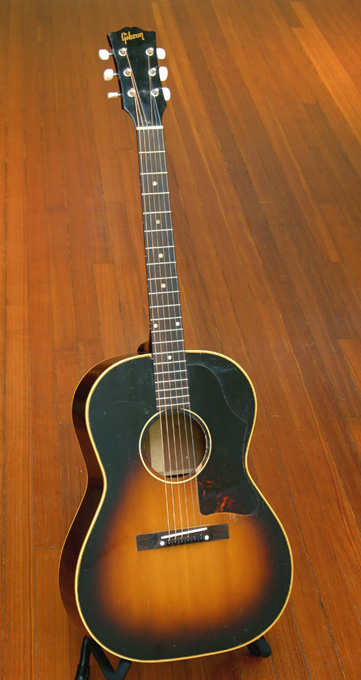 A wonderful, completely crack-free LG-2. The neck was recently set by Mark Erlewine, the frets dressed, and a new saddle installed ... beautifully set up by ME. 1-11/16 inch nut. Mahogany back and sides. Spruce top. Low action, with no buzzing. Nice sustain, and volume.
A wonderful, completely crack-free LG-2. The neck was recently set by Mark Erlewine, the frets dressed, and a new saddle installed ... beautifully set up by ME. 1-11/16 inch nut. Mahogany back and sides. Spruce top. Low action, with no buzzing. Nice sustain, and volume. -
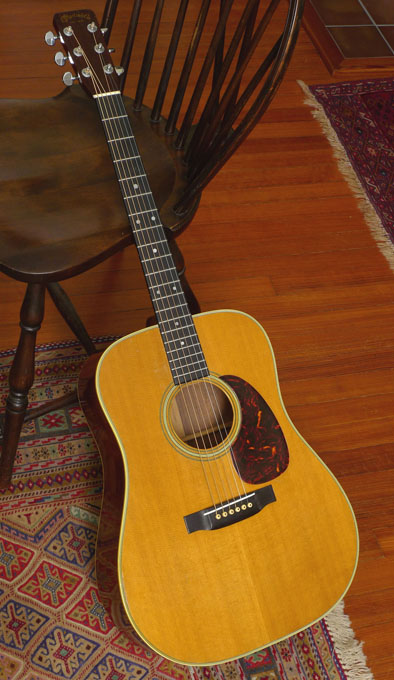 This Brazilian Rosewood D-28 dreadnaught from one of Martin’s finest eras, is special. Its structural integrity, and originality, are rare. And it’s one of the last Martin D-28’s made when Martin still used hide glue for guitar construction. This is a one-owner guitar, still in its original case. When we acquired it, it had not been played for years. Its original bridge, had a split in it, and had come loose from the top. Thus, it sat unplayed in its case for years. But all the wood beneath the bridge was pristine, perfect. So John Allison just made and installed a new exact reproduction bridge, from dark African ebony. It’s perfect, using the exact footprint of the original. The new bridge was attached with hide glue. And we used the original bridge pins.
This Brazilian Rosewood D-28 dreadnaught from one of Martin’s finest eras, is special. Its structural integrity, and originality, are rare. And it’s one of the last Martin D-28’s made when Martin still used hide glue for guitar construction. This is a one-owner guitar, still in its original case. When we acquired it, it had not been played for years. Its original bridge, had a split in it, and had come loose from the top. Thus, it sat unplayed in its case for years. But all the wood beneath the bridge was pristine, perfect. So John Allison just made and installed a new exact reproduction bridge, from dark African ebony. It’s perfect, using the exact footprint of the original. The new bridge was attached with hide glue. And we used the original bridge pins.- Guitar is 100% crack-free (no, not even a pickguard crack)
- 100% original finish, everywhere. No overspray or finish alterations of any kind. Minor dings and some minor pickwear around the soundhole.
- Has never had a strap lug attached
- Perfect condition maple bridge plate
- Original frets are in great condition
- Action is great, with just the right amount of saddle, and neck angle is perfect
-
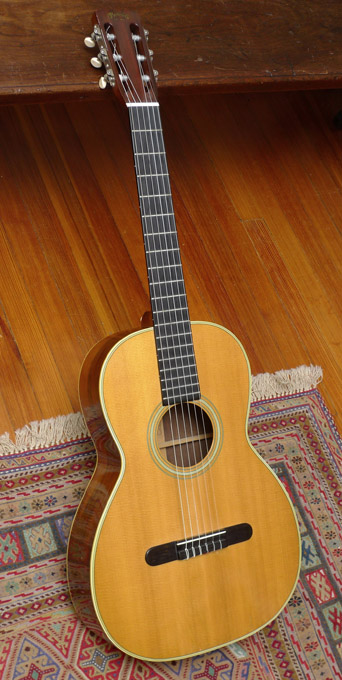 Another wonderful instrument with top grade Brazilian Rosewood back and sides. The Brazilian rosewood on this in instrument is more figured on the sides, and the back shows wonderful bookmatched figuring. This is an all-original guitar. There are no cracks that go through the wood. There are several finish/superficial cracks in the finish, one on the top near the bottom/endpin area, and one on the back. And a bit of crazing in the top finish. Set-up and playability is great. Wonderful full tonal range up and down the fretboard.
Another wonderful instrument with top grade Brazilian Rosewood back and sides. The Brazilian rosewood on this in instrument is more figured on the sides, and the back shows wonderful bookmatched figuring. This is an all-original guitar. There are no cracks that go through the wood. There are several finish/superficial cracks in the finish, one on the top near the bottom/endpin area, and one on the back. And a bit of crazing in the top finish. Set-up and playability is great. Wonderful full tonal range up and down the fretboard. -
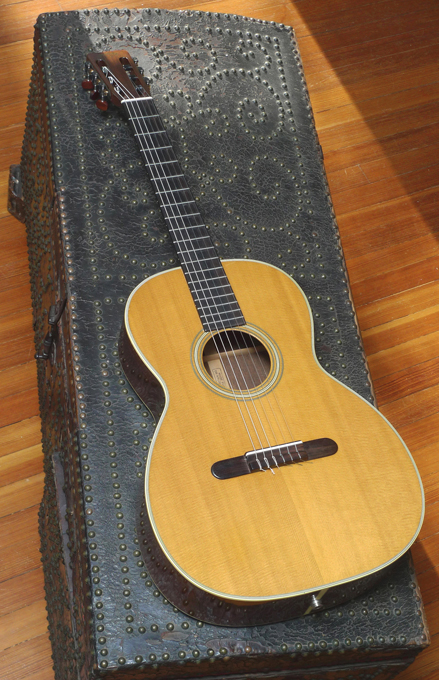 A wonderfully preserved, crack free 12 fret 000-28 Martin, with gorgeous Brazilian rosewood back and sides. The tone of this instrument is wonderful. It stands up to many high end Spanish made classical guitars of the period for Brazilian rosewood warmth. While intentionally not built for concert hall volume, the bass tone and clarity of the trebles on large-bodied Martin nylon strings guitars with Brazilian back and sides is unsurpassed. This instrument is very well set up to play on stage, plugged in, and to record, if desired. It has great high end Gilbert tuners, with black housing, abalone dot and snakewood buttons. (Original tuners, in perfect condition, are in the case, so you can easily replace the originals if desired.) This instrument has an excellent custom engineered stereo pickup system, installed without altering the guitar: The pickup is the undersaddle type, supplied by EMG. The separate mic element is assembled in a foam mounting block with cable, endpin jack, custom made for this guitar. It is unobtrusive in its mounting. Jack is mounted in the endpin hole, so there are no extra holes in the guitar. The output jack is stereo, TRS (Tip wired to pickup, Ring wired to mic, and Sleeve is ground.) The addition of the internal mic adds a realism and depth that no pickup by itself can capture. The EMG pickup is excellent compared to most others in terms of exhibiting less of that harsh piezo sound. The result is a guitar that plays beautifully amplified, or on its own. The Martin “C” has the old elongated Martin 12 fret body. It was offered in the 00-16C, 00-18C and 000-28C in 1962. 1966 saw the last 000-28C. There were not many nylon string, 000-sized 28 models made, and fewer still with the quality of Brazilian rosewood this one has. And the condition on this instrument is stunning. No cracks anywhere, and very little wear at all.
A wonderfully preserved, crack free 12 fret 000-28 Martin, with gorgeous Brazilian rosewood back and sides. The tone of this instrument is wonderful. It stands up to many high end Spanish made classical guitars of the period for Brazilian rosewood warmth. While intentionally not built for concert hall volume, the bass tone and clarity of the trebles on large-bodied Martin nylon strings guitars with Brazilian back and sides is unsurpassed. This instrument is very well set up to play on stage, plugged in, and to record, if desired. It has great high end Gilbert tuners, with black housing, abalone dot and snakewood buttons. (Original tuners, in perfect condition, are in the case, so you can easily replace the originals if desired.) This instrument has an excellent custom engineered stereo pickup system, installed without altering the guitar: The pickup is the undersaddle type, supplied by EMG. The separate mic element is assembled in a foam mounting block with cable, endpin jack, custom made for this guitar. It is unobtrusive in its mounting. Jack is mounted in the endpin hole, so there are no extra holes in the guitar. The output jack is stereo, TRS (Tip wired to pickup, Ring wired to mic, and Sleeve is ground.) The addition of the internal mic adds a realism and depth that no pickup by itself can capture. The EMG pickup is excellent compared to most others in terms of exhibiting less of that harsh piezo sound. The result is a guitar that plays beautifully amplified, or on its own. The Martin “C” has the old elongated Martin 12 fret body. It was offered in the 00-16C, 00-18C and 000-28C in 1962. 1966 saw the last 000-28C. There were not many nylon string, 000-sized 28 models made, and fewer still with the quality of Brazilian rosewood this one has. And the condition on this instrument is stunning. No cracks anywhere, and very little wear at all.